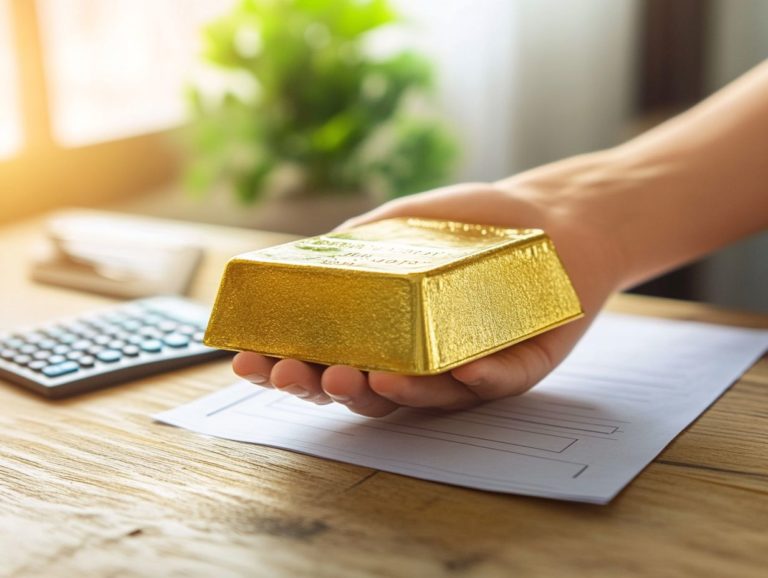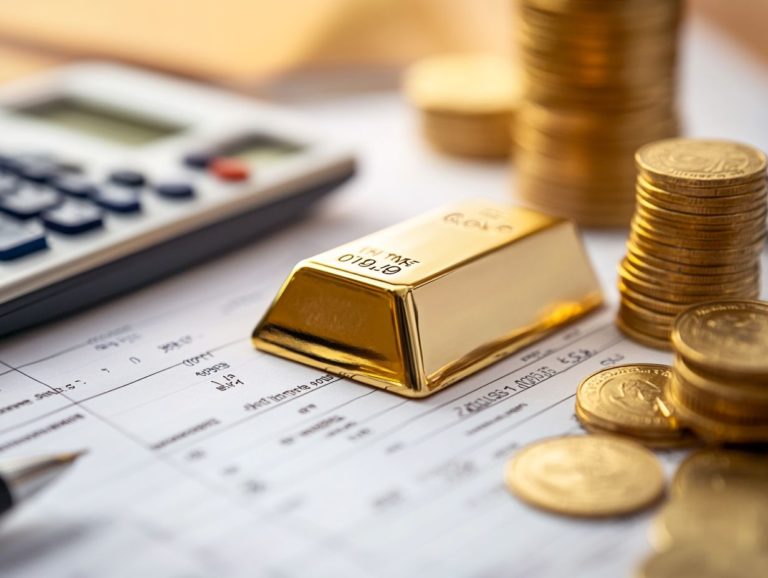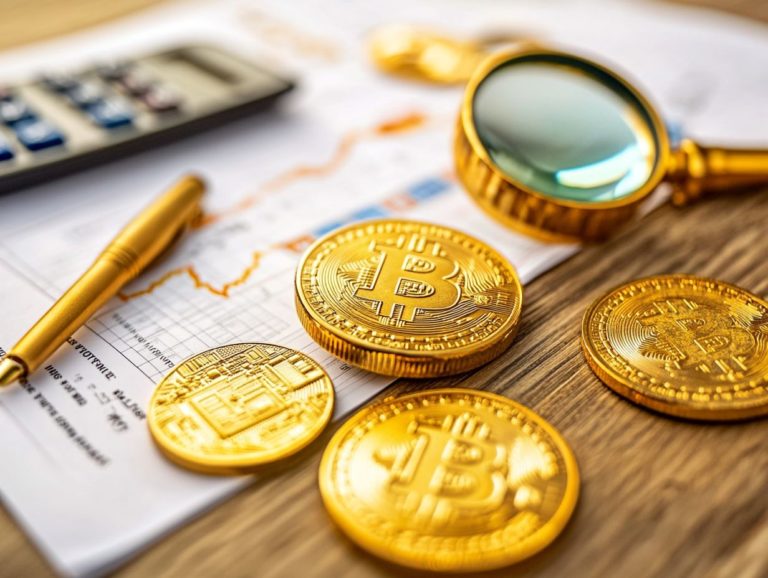5 Best Gold ETFs for Investment
Investing in gold has long been a favored strategy for those seeking stability and a means to preserve their wealth.
With the rise of exchange-traded funds (ETFs), accessing gold investments has become easier and more streamlined than ever before.
This article explores gold ETFs. We will explain how they work, their advantages, and potential risks.
Whether you re an experienced investor or just beginning your journey, you ll discover valuable insights, top recommendations, and essential tips to navigate the world of gold ETFs with confidence.
Dive in to see if this investment avenue aligns with your financial aspirations!
Contents
- Key Takeaways:
- 1. What Are ETFs and Why Are They Popular for Investing?
- 2. How Does Investing in Gold ETFs Work?
- 3. Advantages of Investing in Gold ETFs
- 4. Top 5 Gold ETFs for Investment
- 5. Factors to Consider When Choosing a Gold ETF
- 6. Performance and Historical Data of Top Gold ETFs
- 7. Comparison of Fees and Expenses Among Gold ETFs
- 8. How to Buy and Sell Gold ETFs
- 9. Tax Implications of Investing in Gold ETFs
- 10. Risks Associated with Investing in Gold ETFs
- 11. Tips for Successful Gold ETF Investing
- 12. Common Mistakes to Avoid When Investing in Gold ETFs
- 13. Expert Opinions on Gold ETFs for Investment
- 15. Additional Resources for Gold ETF Investing
- Frequently Asked Questions
Key Takeaways:
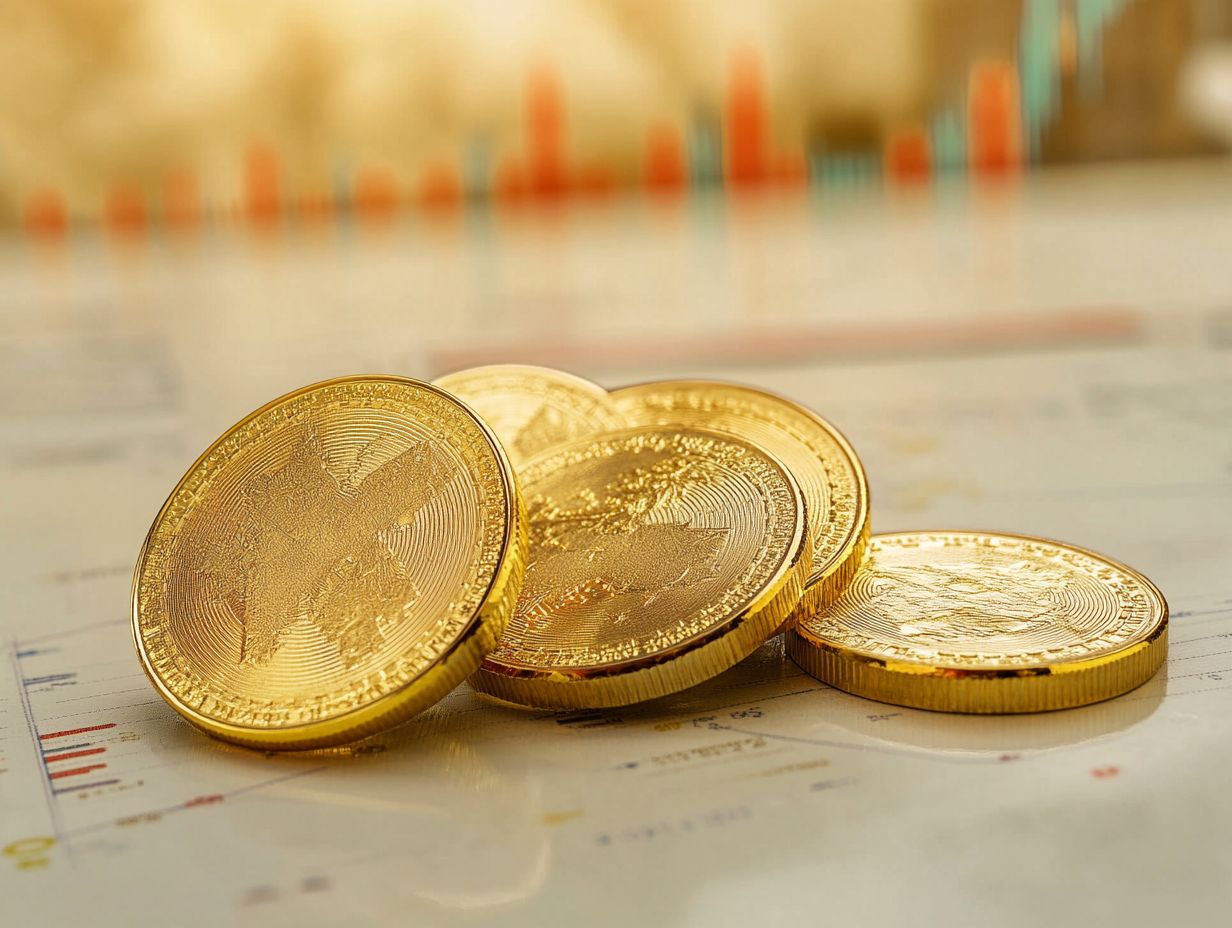
- ETFs are a popular investment option due to their ease of access, diversification, and lower costs compared to traditional options.
- Investing in gold ETFs allows for exposure to the performance of gold without needing physical ownership or storage.
- Gold ETFs offer liquidity, transparency, and flexibility, making them attractive to investors.
1. What Are ETFs and Why Are They Popular for Investing?
Many smart investors are now turning to Exchange-Traded Funds, or ETFs. They offer remarkable flexibility, liquidity (the ease of buying and selling), and cost-effectiveness (affordable options), giving you the power to diversify your portfolio while exploring various asset classes, including gold.
As the demand for safe-haven assets rises and the need to hedge against inflation intensifies, gold-backed ETFs like SPDR Gold Shares and iShares Gold Trust have become essential tools for investors navigating market volatility while striving to meet their financial goals.
ETFs are investment funds that trade on stock exchanges, much like individual stocks, and are designed to mimic the performance of a specific index or asset. This structure grants you exposure to a broad array of securities at a lower cost compared to traditional mutual funds. Their inherent liquidity allows you to buy and sell shares throughout the trading day, providing greater control over your investments.
In today s uncertain economic landscape, gold ETFs are increasingly sought after because they offer easy access to gold a time-honored store of value and effectively bolster portfolio diversification.
By weaving gold ETFs into your investment strategy, you can protect your assets against inflationary pressures, as gold historically retains its value during economic downturns. This makes gold ETFs an exciting choice for anyone eager to protect their wealth!
2. How Does Investing in Gold ETFs Work?
Investing in gold ETFs means you re purchasing shares in funds that hold physical gold or gold-related assets. This allows you to gain exposure to the ever-fluctuating gold prices without the hassle of storing physical gold yourself.
These funds typically track the price of gold through various mechanisms, such as owning physical bullion or engaging in futures contracts (agreements to buy or sell gold at a future date and price) that reflect gold s market value. It’s important to note the distinctions between physical gold-backed ETFs, which are directly tied to specific amounts of gold stored securely, and those that invest in mining stocks, which can be influenced by different market dynamics.
By opting for gold ETFs, you can tailor your investment strategy to align with your financial goals. This approach accommodates a wide range of risk tolerances from more conservative investors seeking stability against inflation to those eager for growth through exposure to the mining sector’s potential.
3. Advantages of Investing in Gold ETFs
Investing in gold ETFs opens up a world of benefits that can supercharge your investment portfolio! They enhance diversification, serve as a reliable hedge against inflation (which means they can help protect your money’s value when prices rise), and exhibit a lower correlation with traditional assets. This makes them a safe haven during economic uncertainty and market turbulence.
Gold ETFs offer unparalleled liquidity. They let you buy and sell shares swiftly during market hours without the hassles tied to physical gold. This ease of trading gives you the power to make quick adjustments to your investment strategies.
Plus, with lower expense ratios compared to mutual funds, you can significantly reduce your overall costs, making these financial instruments particularly appealing.
By eliminating the need for storage and insurance, gold ETFs greatly enhance convenience. Together, these benefits make gold ETFs a smart choice for any portfolio, enabling you to navigate fluctuating markets with greater confidence.
4. Top 5 Gold ETFs for Investment
When exploring investment options in gold ETFs, you ll find standout choices like SPDR Gold Shares, iShares Gold Trust, and VanEck Gold Miners. Each of these contenders boasts unique features and performance metrics designed to align with your specific investment strategies.
In the world of gold ETFs, these options provide not only exposure to the precious metal but also distinct advantages tailored to your diverse financial goals. SPDR Gold Shares stands out with its substantial assets under management, recognized for its liquidity and consistent performance ideal for those seeking a straightforward approach to investing in gold. Additionally, staying informed about 5 essential gold investment trends to watch can further enhance your investment strategy.
On the flip side, iShares Gold Trust catches the eye of investors who prioritize lower expense ratios. This makes it a perfect fit if you’re concerned about costs eroding your returns. Additionally, for those interested in silver, exploring the best silver investment funds of 2024 can provide valuable options.
Meanwhile, VanEck Gold Miners targets a different niche by focusing on mining companies, presenting potential for growth alongside the price of the underlying metal. This option suits both conservative and aggressive investment styles, giving you flexibility in how you navigate the market.
5. Factors to Consider When Choosing a Gold ETF
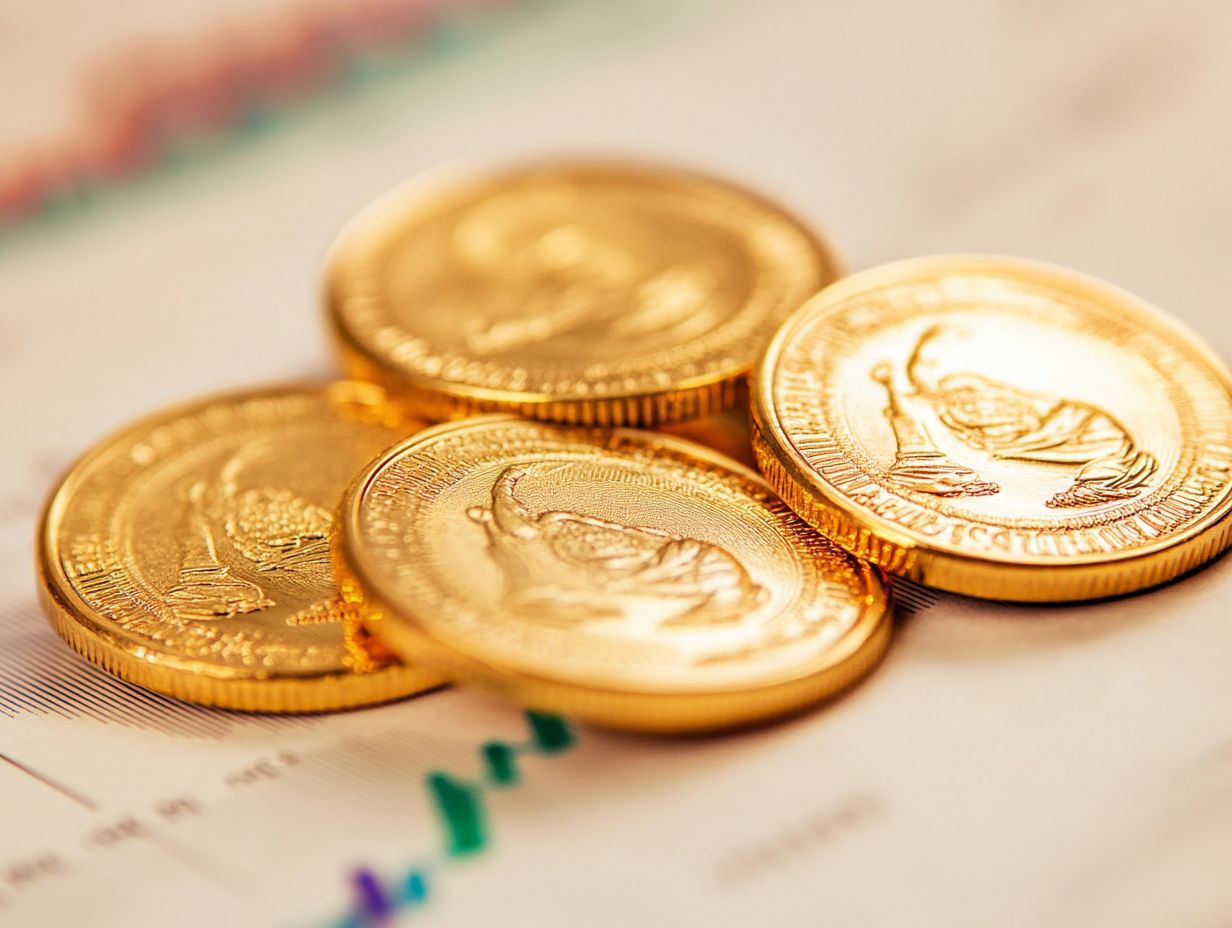
Choosing the right gold ETF demands your careful attention to several key factors, including the fund’s expense ratio, historical performance, and the associated risks that align with your individual investment strategy.
Pay special attention to management fees. These can have a notable impact on your long-term returns, especially in a sector known for its volatility, like precious metals.
Liquidity is another crucial element. Opting for a fund with higher liquidity allows you to enter or exit positions with greater ease, minimizing any disruption to market prices.
Be mindful of the difference between the ETF’s performance and the actual price of gold as well, since this metric reveals how closely the ETF tracks its underlying assets.
Consider the specific assets within the fund, as they can sway price movements in various ways.
By evaluating these factors in line with your personal financial goals, you’ll be poised for a more strategic and informed investment approach.
6. Performance and Historical Data of Top Gold ETFs
Analyzing the performance and historical data of leading gold ETFs offers you invaluable insights into their long-term viability and how well they align with effective investment strategies geared toward growth and stability.
By examining key performance metrics, you can discern how these investment vehicles have consistently adapted to shifts in economic conditions, showcasing a clear trend of rising gold prices during times of market volatility.
It’s particularly noteworthy that during past economic downturns, gold ETFs have frequently outperformed traditional asset classes. This reinforces their reputation as a hedge against inflation and market uncertainties.
You may find it especially enlightening to compare the reactive patterns of gold ETFs with those of stocks and bonds. The latter have historically demonstrated a greater vulnerability to market fluctuations. This highlights the critical importance of diversification in your investment portfolio.
7. Comparison of Fees and Expenses Among Gold ETFs
A detailed comparison of fees and expenses among gold ETFs highlights the importance of expense ratios and trading costs in maximizing your investment returns, especially in volatile markets.
When choosing a gold ETF, it’s easy to overlook how these elements can gradually reduce your potential gains. Major gold ETFs often have varying expense ratios, including management fees and operational costs. These expenses can directly impact your net returns, particularly in a fluctuating market where each basis point counts.
Watch out for hidden fees, such as sales charges or custody fees, which can further erode your investment performance. Understanding trading costs like commissions and spreads is vital, as these can add up quickly with frequent transactions.
So, when selecting an ETF, take the time to carefully evaluate all associated costs. This ensures you make a well-informed decision that aligns with your financial objectives.
8. How to Buy and Sell Gold ETFs
Buying and selling gold ETFs is a straightforward experience. You can navigate this through various brokerage accounts, giving you easy access to this valuable investment from the comfort of your home.
If you don’t already have a brokerage account, your first step is to open one. Make sure to select a platform that offers a diverse range of ETFs. Once your account is funded, you can easily search for gold ETFs using the platform’s search feature. For additional insights, check out the 5 best gold investment websites for 2024.
When you’re ready to buy, grasp the difference between market orders, which execute instantly at the current market price, and limit orders, which allow you to control the price you want to pay. Timing and market trends can significantly affect your transaction outcomes, so it s wise to develop a strategy that aligns with your investment goals, whether you re focused on short-term trading or long-term holding.
9. Tax Implications of Investing in Gold ETFs
Be mindful of the tax implications tied to investing in gold ETFs, as these can differ significantly from other investment vehicles and may influence your overall returns based on your individual investment strategy.
The IRS typically treats gold ETFs as collectibles, meaning you could face capital gains taxes at a maximum rate of 28% when you sell at a profit. This contrasts with long-term capital gains from stocks, which usually enjoy a lower tax rate of 0% to 20%.
While gold ETFs may offer benefits like ease of trading and liquidity, they also come with potential downsides, including a higher tax liability compared to holding physical gold, which sometimes qualifies for more favorable capital gains treatment.
Therefore, consulting a tax professional can be invaluable in navigating these complexities and optimizing your investment strategy.
10. Risks Associated with Investing in Gold ETFs
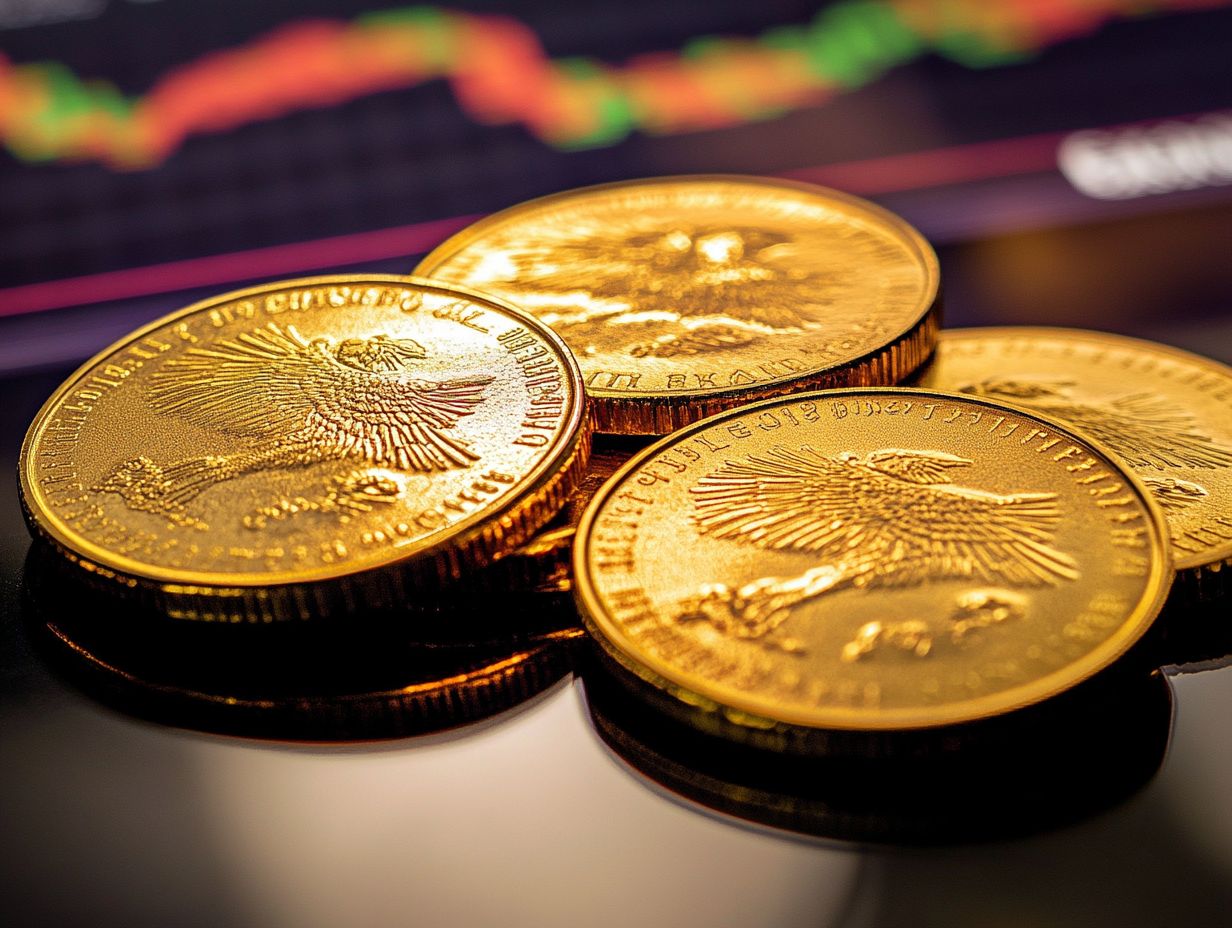
Diving into gold ETFs? Be aware of the risks that come with the territory, including market volatility, fluctuations in gold prices, and how well these investments align with your personal financial goals and risk tolerance.
Macroeconomic factors, such as economic downturns, can significantly impact the performance of these ETFs, potentially leading to unexpected losses. Geopolitical tensions can introduce uncertainty, causing gold prices to swing unpredictably. It’s essential to understand how these external elements can affect your investments.
Equally important is the performance of the underlying assets that the ETF tracks. If these assets aren t performing well, your entire investment could take a hit. Therefore, taking the time to understand these risks is crucial for making informed investment decisions.
11. Tips for Successful Gold ETF Investing
To achieve successful investment outcomes in gold ETFs, adopt a well-defined investment strategy that includes thorough research, diversification, and a keen grasp of market trends.
Start by establishing clear financial goals. This will help you tailor your portfolio to meet specific objectives over time. Monitoring market conditions consistently provides vital insights for buying or selling at optimal times.
If you are experienced in investing, periodically rebalance your portfolio to maintain your desired risk level and optimize returns.
Stay informed about global economic indicators that may influence gold prices. This knowledge enhances your decision-making process and allows you to refine your strategy with confidence.
12. Common Mistakes to Avoid When Investing in Gold ETFs
Investors often stumble into common pitfalls with gold ETFs. You might skip essential research, overlook pesky expense ratios, or let emotions steer your decisions.
These missteps can lead to disappointing returns and increased risks, jeopardizing your financial aspirations. To navigate these challenges, prioritize thorough analysis of market trends and performance indicators.
Keep an eye on expense ratios and management fees; lower costs can significantly boost your long-term profits.
Cultivate a disciplined investment strategy and set predefined exit plans to keep emotions in check during market turbulence. This approach leads to more resilient investment outcomes.
13. Expert Opinions on Gold ETFs for Investment
Industry experts provide valuable insights on gold ETFs, highlighting their significant role in investment strategies, especially during uncertain economic times.
Recent discussions show that these funds that trade like stocks act as a safeguard against inflation and currency fluctuations, making them appealing during market volatility. Investment strategists recommend including gold ETFs in your portfolio for better diversification and stabilized returns.
They emphasize that gold ETFs usually have a low correlation with traditional asset classes like stocks and bonds, helping to mitigate overall risk.
As global economic uncertainties unfold, the consensus is clear: integrating gold ETFs into your investment approach can balance growth with protection.
15. Additional Resources for Gold ETF Investing
If you’re eager to deepen your understanding of gold ETF investing, a wealth of resources is available. Financial news platforms, investment guides, and expert blogs offer valuable insights tailored just for you.
Websites like Investopedia and The Motley Fool serve up a treasure trove of articles that clarify various financial concepts, including gold ETFs, and outline effective investment strategies crucial for your success.
Books like “The Intelligent Investor” by Benjamin Graham and specialized guides on precious metal investing can act as comprehensive references to elevate your knowledge.
Engaging with online forums and attending webinars hosted by investment professionals helps you stay updated on real-time market trends and collective wisdom.
Remember, the continuous pursuit of education in investing empowers you to make informed decisions and navigate market fluctuations with confidence. Dive into these resources to boost your knowledge and confidence in gold ETF investing!
Frequently Asked Questions
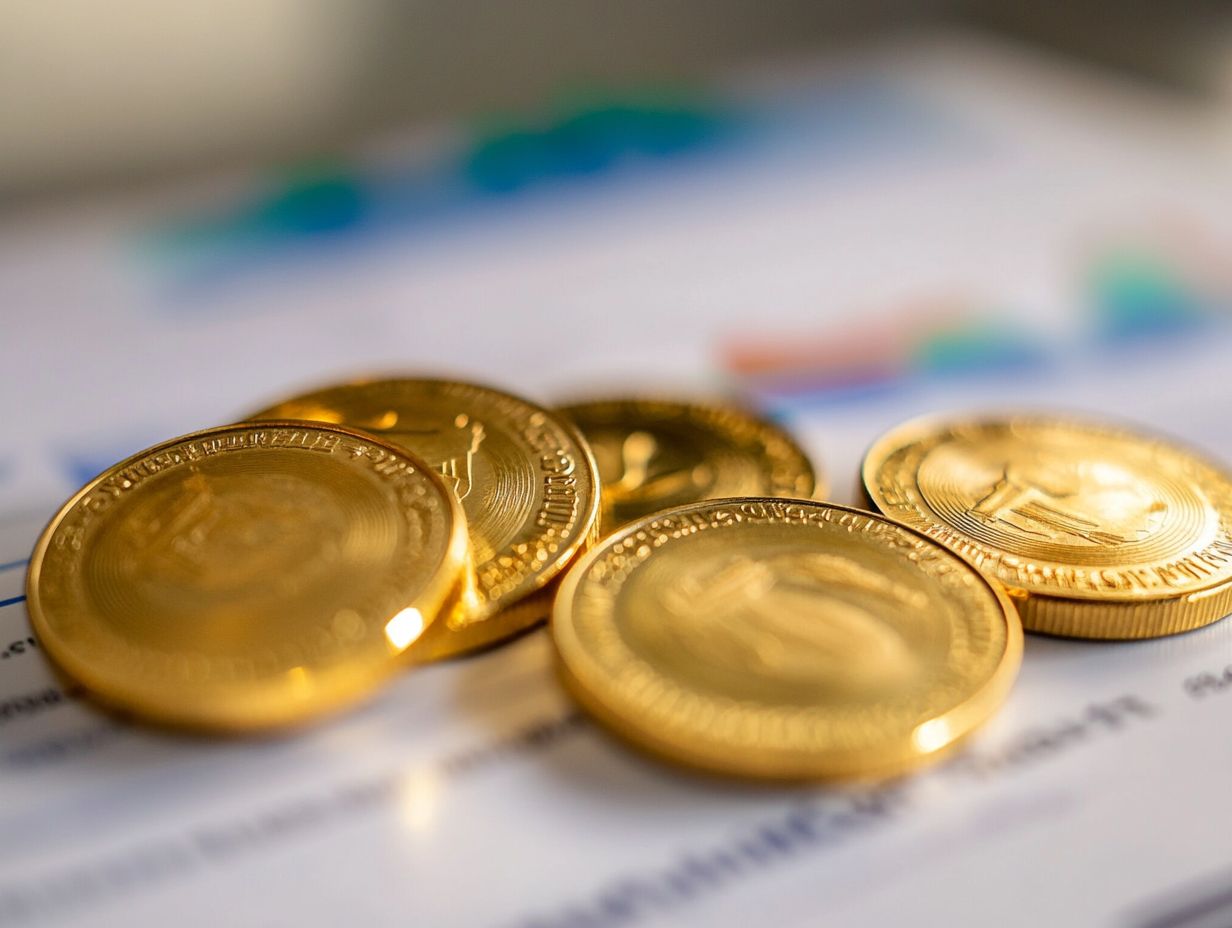
What are some of the best gold ETFs for investment?
- SPDR Gold Shares (GLD): One of the largest and most well-known gold ETFs, offering exposure to gold bullion.
- iShares Gold Trust (IAU): A cost-effective option that tracks the price of gold, suitable for long-term investors.
- VanEck Vectors Gold Miners ETF (GDX): Focuses on gold mining companies, providing a different exposure to the gold sector.
- Invesco DB Gold Fund (DGL): Invests in gold futures contracts, appealing to investors willing to take on more risk.
- Aberdeen Standard Physical Swiss Gold Shares ETF (SGOL): Offers physical gold stored in Switzerland, appealing for its safety and transparency.
Why should I consider investing in gold ETFs?
Gold ETFs allow you to invest in gold’s price movements without owning the metal itself. They are a smart, cost-effective way to diversify your portfolio.
Which gold ETFs have the lowest expense ratios?
The iShares Gold Trust (IAU) and SPDR Gold Shares (GLD) stand out with low expense ratios of 0.25% and 0.40%, respectively.
Do gold ETFs pay dividends?
Gold ETFs usually do not pay dividends since they do not generate income. Their value is tied to gold’s market price instead.
What should I consider when choosing a gold ETF?
Consider factors like the expense ratio, tracking error, and liquidity. Research the fund s performance and holdings to make an informed choice.
What are the risks of investing in gold ETFs?
Investing in gold ETFs carries risks, just like any other investment. Market volatility, geopolitical events, and gold price fluctuations can impact your investment. Research and monitor regularly to stay informed.










